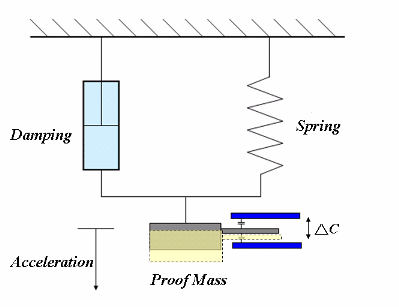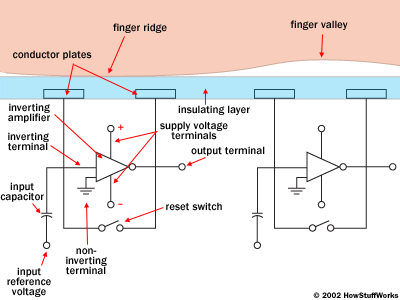Various Capacitive Sensors
Over the years, brilliant minds have used the science and nature of capacitors to create some truly amazing and accurate sensors so that electronics can measure and correspond with the physical world we see everyday.
 Flexible
conductive plates are the main component of condenser
microphones. Invented at Bell Labs in 1916, the condenser
microphone is one of the earliest methods of capturing
sound. A diaphragm, the flexible plate of a capacitor, is
moved/deformed by sound waves in the air. As voltage is
held constant across the plates, the capacitance can be
measured as the distance between the plates changes.
Flexible
conductive plates are the main component of condenser
microphones. Invented at Bell Labs in 1916, the condenser
microphone is one of the earliest methods of capturing
sound. A diaphragm, the flexible plate of a capacitor, is
moved/deformed by sound waves in the air. As voltage is
held constant across the plates, the capacitance can be
measured as the distance between the plates changes.
http://www.mediacollege.com/audio/microphones/condenser.html
Capacitive accelerometers  are not the only kind of
accelerometer, but it is effective. As a mass is
accelerated, a plate is moved, thus the capacitance is
effected/measured. A system known as MEMS (Micro
Electo-Mechanical Systems) is often what makes up a
capacitive accelerometer. These micro-mechanical systems
can be made incredibly small and can be made to represent
the figure to the right. These components can be strapped
to rockets, used to deploy airbags, make your Mario Kart
turn on your Wii video game console, and much much
more.
are not the only kind of
accelerometer, but it is effective. As a mass is
accelerated, a plate is moved, thus the capacitance is
effected/measured. A system known as MEMS (Micro
Electo-Mechanical Systems) is often what makes up a
capacitive accelerometer. These micro-mechanical systems
can be made incredibly small and can be made to represent
the figure to the right. These components can be strapped
to rockets, used to deploy airbags, make your Mario Kart
turn on your Wii video game console, and much much
more.
A little more in-depth look at capacitive
accelerometers:
https://wiki.metropolia.fi/display/sensor/Acceleration+sensors
https://www.youtube.com/watch?v=i2U49usFo10
 One of the newest features in cell phones have people very
excited. Fingerprint Scanners!! We're in the future 0_o.
Looking over the security risks of this technology, it is
a very elegant use of capacitors. By measuring the various
voltages across several different capacitors, or measuring
as a user slides their finger over the sensor, the cell
phone or computer can map the ridges and valleys that make
up a fingerprint. An important aspect of this technology
is that the finger of the user is actually the other
conducting plate in these capacitors! This method of
sensing will be explored in further detail on the next
page (Screens).
One of the newest features in cell phones have people very
excited. Fingerprint Scanners!! We're in the future 0_o.
Looking over the security risks of this technology, it is
a very elegant use of capacitors. By measuring the various
voltages across several different capacitors, or measuring
as a user slides their finger over the sensor, the cell
phone or computer can map the ridges and valleys that make
up a fingerprint. An important aspect of this technology
is that the finger of the user is actually the other
conducting plate in these capacitors! This method of
sensing will be explored in further detail on the next
page (Screens).
http://computer.howstuffworks.com/fingerprint-scanner3.htm
Liquid level sensors use a changing
dielectric to effect the capacitance.  The parallel plates are charged to a
voltage. As the liquid level rises, perpendicular to the
vertical plates, more dielectric is introduced between the
two plates, thus boosting the capacitance. A measurement
at empty and one at full is all a processor needs to
accurately map the amount of liquid in the container at
any level. This method is often used in airplanes to
measure the fuel level. The gauge to the right may look a
little odd for a capacitor but do not fret, the parallel
plates are merely concentric tubes.
The parallel plates are charged to a
voltage. As the liquid level rises, perpendicular to the
vertical plates, more dielectric is introduced between the
two plates, thus boosting the capacitance. A measurement
at empty and one at full is all a processor needs to
accurately map the amount of liquid in the container at
any level. This method is often used in airplanes to
measure the fuel level. The gauge to the right may look a
little odd for a capacitor but do not fret, the parallel
plates are merely concentric tubes.
http://cdn.racerpartswholesale.com/images/uploads/11875_2884_large.jpg